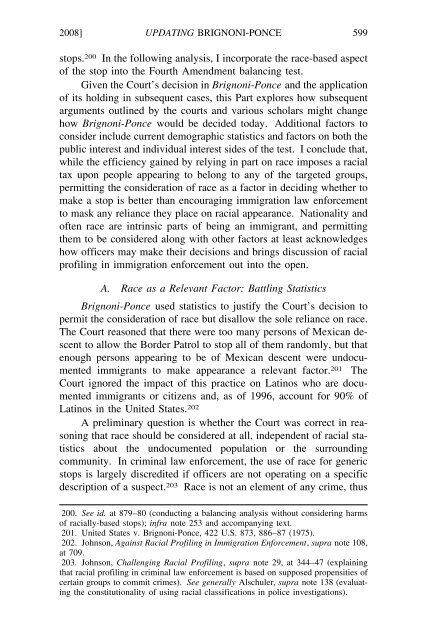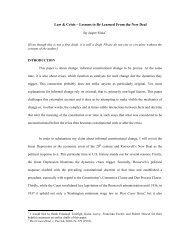updating brignoni-ponce - New York University School of Law
updating brignoni-ponce - New York University School of Law
updating brignoni-ponce - New York University School of Law
Create successful ePaper yourself
Turn your PDF publications into a flip-book with our unique Google optimized e-Paper software.
2008] UPDATING BRIGNONI-PONCE 599<br />
stops. 200 In the following analysis, I incorporate the race-based aspect<br />
<strong>of</strong> the stop into the Fourth Amendment balancing test.<br />
Given the Court’s decision in Brignoni-Ponce and the application<br />
<strong>of</strong> its holding in subsequent cases, this Part explores how subsequent<br />
arguments outlined by the courts and various scholars might change<br />
how Brignoni-Ponce would be decided today. Additional factors to<br />
consider include current demographic statistics and factors on both the<br />
public interest and individual interest sides <strong>of</strong> the test. I conclude that,<br />
while the efficiency gained by relying in part on race imposes a racial<br />
tax upon people appearing to belong to any <strong>of</strong> the targeted groups,<br />
permitting the consideration <strong>of</strong> race as a factor in deciding whether to<br />
make a stop is better than encouraging immigration law enforcement<br />
to mask any reliance they place on racial appearance. Nationality and<br />
<strong>of</strong>ten race are intrinsic parts <strong>of</strong> being an immigrant, and permitting<br />
them to be considered along with other factors at least acknowledges<br />
how <strong>of</strong>ficers may make their decisions and brings discussion <strong>of</strong> racial<br />
pr<strong>of</strong>iling in immigration enforcement out into the open.<br />
A. Race as a Relevant Factor: Battling Statistics<br />
Brignoni-Ponce used statistics to justify the Court’s decision to<br />
permit the consideration <strong>of</strong> race but disallow the sole reliance on race.<br />
The Court reasoned that there were too many persons <strong>of</strong> Mexican descent<br />
to allow the Border Patrol to stop all <strong>of</strong> them randomly, but that<br />
enough persons appearing to be <strong>of</strong> Mexican descent were undocumented<br />
immigrants to make appearance a relevant factor. 201 The<br />
Court ignored the impact <strong>of</strong> this practice on Latinos who are documented<br />
immigrants or citizens and, as <strong>of</strong> 1996, account for 90% <strong>of</strong><br />
Latinos in the United States. 202<br />
A preliminary question is whether the Court was correct in reasoning<br />
that race should be considered at all, independent <strong>of</strong> racial statistics<br />
about the undocumented population or the surrounding<br />
community. In criminal law enforcement, the use <strong>of</strong> race for generic<br />
stops is largely discredited if <strong>of</strong>ficers are not operating on a specific<br />
description <strong>of</strong> a suspect. 203 Race is not an element <strong>of</strong> any crime, thus<br />
200. See id. at 879–80 (conducting a balancing analysis without considering harms<br />
<strong>of</strong> racially-based stops); infra note 253 and accompanying text. R<br />
201. United States v. Brignoni-Ponce, 422 U.S. 873, 886–87 (1975).<br />
202. Johnson, Against Racial Pr<strong>of</strong>iling in Immigration Enforcement, supra note 108, R<br />
at 709.<br />
203. Johnson, Challenging Racial Pr<strong>of</strong>iling, supra note 29, at 344–47 (explaining R<br />
that racial pr<strong>of</strong>iling in criminal law enforcement is based on supposed propensities <strong>of</strong><br />
certain groups to commit crimes). See generally Alschuler, supra note 138 (evaluat- R<br />
ing the constitutionality <strong>of</strong> using racial classifications in police investigations).
















